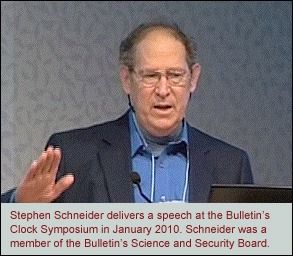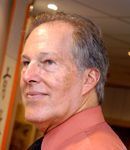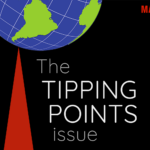The passing of a climate prodigy
By Richard C. J. Somerville | July 23, 2010
 Stephen Schneider delivers a speech at the Bulletin's Clock Symposium in January 2010. Schneider was a member of the Bulletin's Science and Security Board.
Stephen Schneider delivers a speech at the Bulletin's Clock Symposium in January 2010. Schneider was a member of the Bulletin's Science and Security Board.
A towering figure in climate science, Stephen H. Schneider, 65, died of an apparent heart attack on July 19, 2010, while flying to London from a conference in Stockholm. The loss of Schneider, a professor at Stanford University, deprives the world of both an outstanding researcher and a gifted science communicator. To his colleagues in climate science, Steve, as everybody called him, has long been known as a scientific pioneer and a role model. For four decades, he tirelessly carried out research, explained climate science to the wider world, and advocated rational responses to the threat of human-caused climate change.
Schneider, born in New York City, was first attracted to the infant science of climate change while a graduate student at Columbia University in the late 1960s. There he studied mechanical engineering, fluid dynamics, and plasma physics. Climatology in the 1960s was still largely a scientific backwater devoted to compiling weather statistics. Schneider was at the center of what was to become a genuine scientific revolution. In 1971, while a postdoctoral fellow at the NASA Goddard Institute for Space Studies (GISS) in New York, he published one of the first attempts to model the effects of carbon dioxide and atmospheric aerosols on climate. In 1972, Schneider left GISS for the National Center for Atmospheric Research (NCAR) in Boulder, Colorado, where he would stay for 20 years before moving to Stanford. At NCAR, he was among the first to recognize and analyze the large potential influence of cloud feedbacks on climate change.
Schneider quickly demonstrated talents and traits that would endure for life. He was an intense, driven, high-energy scientist, who, well before most, realized that climate science was inherently interdisciplinary. He was always highly collaborative, working productively with an extremely wide range of scientists. He was drawn toward the world of science policy and the broad implications of climate change for society. He was unfailingly generous and altruistic in supporting and counseling other scientists. Many leaders in the climate science community today credit him with influencing and aiding their careers. His integrity–both personal and scientific–was absolute. He had a prodigious work ethic and published prolifically throughout his career. He was courageous when facing adversity and invariably courteous to those who disagreed with him.
It must be said that Schneider also had an ego, talked nonstop, and loved being on television. If these are character flaws, then we surely need more flawed characters just like him. Journalists quickly learned that Schneider was the scientist to seek out whenever a complex climate science story needed to be told. They would immediately get an articulate answer from him to any question. It would be free of jargon, scientifically accurate, direct, and to the point. Schneider invented the term “mediarology” and later built a section of his Stanford website to explain how scientists could more effectively interact with journalists.
At NCAR, Schneider was a key participant in forming a new climate science program in 1972, while he was still a postdoctoral fellow. In 1975, at age 30, he boldly founded a new interdisciplinary journal, Climatic Change. He would edit this journal for the rest of his life. In recent years, he quietly subsidized the salaries of its small staff out of his own pocket. Schneider also published several books popularizing climate science for a general audience, beginning with The Genesis Strategy in 1976. This book predicted that greenhouse gases would cause a “demonstrable” climate change by the end of the century. Characteristically, Schneider was ahead of his time.
As climate change became a subject of great scientific interest as well as public concern, the obvious excellence of Schneider’s research and his ability to explain science to the wider world solidified his outstanding international reputation. The creation of the Intergovernmental Panel on Climate Change (IPCC) in 1988 marked global recognition of the need to bring the best scientific information to the attention of policymakers. Schneider’s wide-ranging knowledge, and his ability to move easily between the worlds of physical science, social science, policymakers, and the press, made him an indispensable asset to IPCC. He was a lead author for all four of the major IPCC assessment reports to date, as well as for two synthesis reports. He consulted for every U.S. administration since that of Richard Nixon and frequently testified before Congress.
In 2001, Schneider was diagnosed with mantle cell lymphoma, an especially aggressive life-threatening cancer. This is a rare type of non-Hodgkins lymphoma for which there is no standard cure and for which very few clinical trials data are available. Schneider, typically rational, found parallels with problems in climate science and decided to partner actively with his medical team in designing his treatment path. He later said that his doctors explained oncology to him while he explained Bayesian statistical inference theory to them. With strong support, especially from his wife, Terry Root, herself an eminent scientist and frequent research collaborator with Schneider, the treatment was successful. For him, the long ordeal was a teachable moment, and he produced an inspiring book about it, The Patient from Hell. Despite the painful and exhausting treatment, involving radiation, chemotherapy, and bone marrow transplants, he continued to work from the hospital.
Schneider was a member of the Bulletin‘s Science and Security Board. Recognized by many honors, he received a MacArthur Fellowship “genius award” in 1992 and was elected to the National Academy of Sciences in 2002. His last book, Science as a Contact Sport, a scientific autobiography, appeared in 2009. A recounting of his four decades of experience in both climate science and climate policy, it is the single best source for those who want to know more about Schneider as a scientist and a public intellectual. For those of us who were fortunate enough to have been Schneider’s colleagues and friends: Although his eloquent voice has now been silenced, his powerful influence on us all is indelible, and the example of the life he led will continue to be an inspiration.
Together, we make the world safer.
The Bulletin elevates expert voices above the noise. But as an independent nonprofit organization, our operations depend on the support of readers like you. Help us continue to deliver quality journalism that holds leaders accountable. Your support of our work at any level is important. In return, we promise our coverage will be understandable, influential, vigilant, solution-oriented, and fair-minded. Together we can make a difference.
Topics: Climate Change, Opinion















